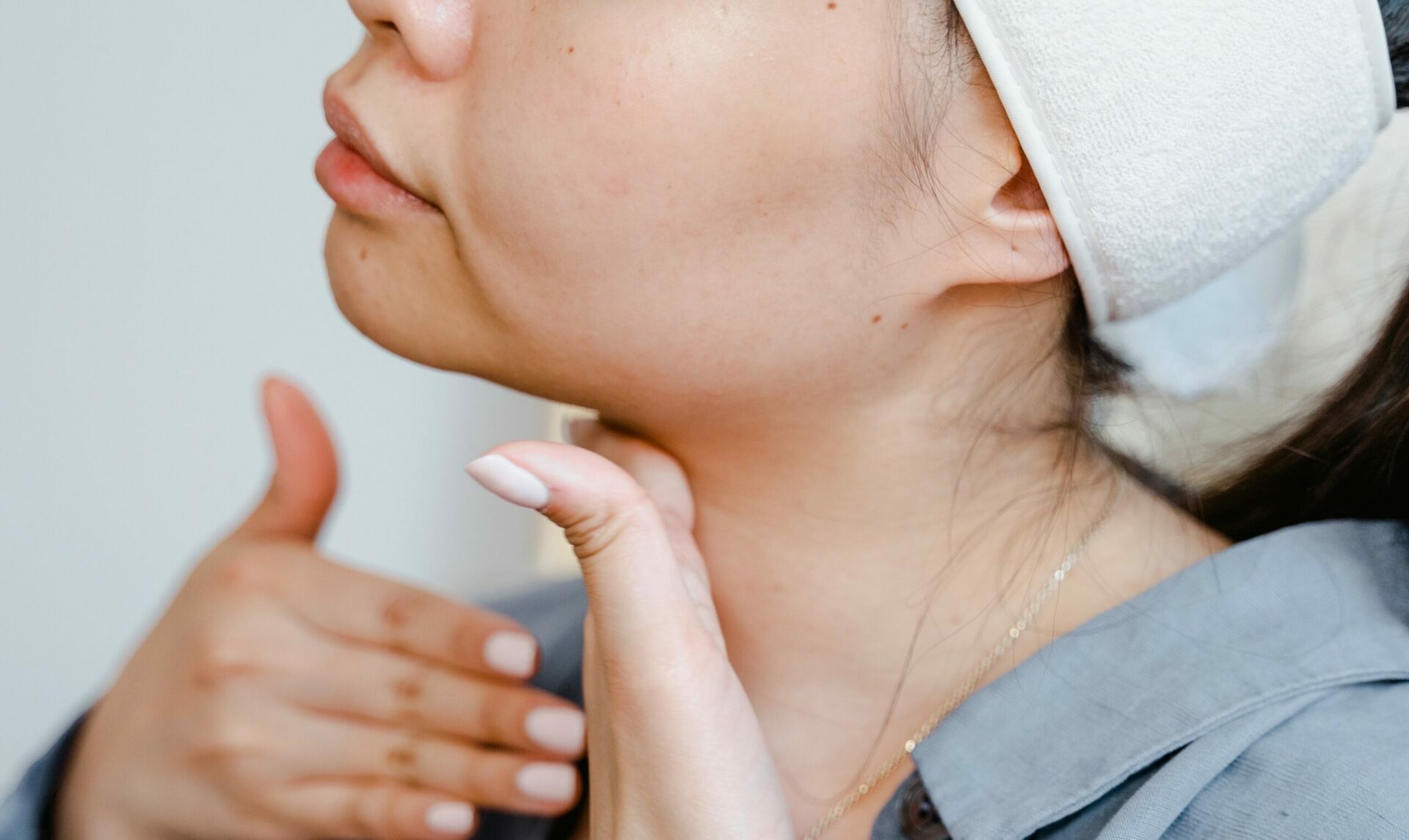Hashimoto's thyroiditis, also called chronic lymphocytic thyroiditis or "Hashimoto's" for short, is a chronic inflammation of the thyroid gland.
What you should know about Hashimoto's thyroiditis
What does the thyroid gland do?
The thyroid gland (medical term: thyroid gland) is a vital, small hormone gland located in the front of the neck below the larynx that produces vital thyroid hormones. It is essential for metabolism, growth and maturation of the body and involved in the regulation of various bodily functions. It continuously releases a certain amount of thyroid hormones into the blood. As soon as the metabolism requires more energy, for example in cold weather, during growth or during pregnancy, the thyroid cranks up its hormone production.
How does Hashimoto develop?

Hashimoto's" is a so-called autoimmune disease. This means that its causes are due to a defective body defense.
A healthy Immunesystem renders foreign bacteria or viruses that enter the body harmless by forming appropriate antibodies against them. It is also responsible for eliminating infected or severely damaged body cells.
In an autoimmune disease, however, the immune system mistakenly attacks healthy endogenous tissue - in the case of Hashimoto's thyroiditis, it attacks thyroid tissue.
This autoimmune reaction eventually leads to persistent inflammation of the thyroid gland.
What is the course of the autoimmune disease?
In the beginning, the disease is often symptom-free, since the organism can still balance the hormone levels as far as possible at the beginning. In the course of the disease, hyperthyroidism usually develops first, followed by hypothyroidism.
As soon as the hormone stores of the thyroid gland become inflamed, an overdose of thyroid hormones is often released into the blood. This triggers complaints of hyperthyroidism.
Over time, the tissue of the thyroid gland is damaged by the inflammation to the extent that its functionality is impaired. This results in an excessively low level of thyroid hormones, causing symptoms of hypothyroidism.
Possible causes
What leads to this erroneous assessment of the organism has not yet been fully researched. The following causes may play a role:
- Genetic predisposition
- Iodine level too high
- Hormone fluctuations during puberty, pregnancy and menopause
- Stress and mental strain
- Serious diseases such as carcinoma, heart attack
Who does the disease affect and when does it occur?

Hashimoto's thyroiditis is one of the most common forms of hypothyroidism in adults and affects about five to ten percent of the population. It usually occurs between the ages of 30 and 50.
Women are affected about nine times more often than men, with the first symptoms often occurring at the same time as menopause. As a result, thyroiditis easily goes unnoticed because the symptoms are attributed to menopause.
The following symptoms may develop
When the hormone production of the thyroid gland is disturbed, many different body processes are affected. Therefore, it can manifest itself in completely different symptoms. At first, there are hardly any symptoms, which is why the disease is not noticed until later, when it already manifests itself in hypothyroidism.
In the initial stage of Hyperthyroidism can occur:
- Sweating and warm moist skin
- Increased pulse (hypertension)
- Weight loss despite cravings
- Diarrhea
- restlessness, nervousness, irritability and mood swings
- Sleep disorders and insomnia
- Muscle weakness and tremor
- Heart palpitations and palpitations (tachycardia) up to cardiac arrhythmia
- Thickened neck due to a pathologically enlarged thyroid gland (goiter)
Possible symptoms of the Hypothyroidism are:
- Physical exhaustion, weakness and fatigue
- Freezing and increased sensitivity to cold
- Reduced thyroid gland
- Weight gain despite balanced diet
- Dry, brittle hair or hair loss, dry skin and brittle nails.
- Swelling in the face, often around the eyes, or on the arms and legs
- Hoarseness, frequent throat clearing and coughing
- Constipation
- Low pulse
- cycle disturbances, reduced fertility, or Menstrual cramps
- Elevated blood lipid levels
- Erectile dysfunction, loss of libido
- Susceptibility to infections
- Depressive moods, listlessness, restlessness and nervousness
- Concentration difficulties and memory problems
How sufferers can be helped
How is Hashimoto diagnosed?
If there are signs of thyroid disease, the thyroid gland is palpated first and may also be examined in more detail by ultrasound.
Hashimoto's thyroiditis is finally diagnosed by means of a blood test. On the one hand, this measures the so-called thyroid levels, i.e. the thyroid hormones themselves as well as thyroid-stimulating hormone (TSH), which is produced in the pituitary gland and controls the function of the thyroid gland. On the other hand, the blood is examined for typical antibodies directed against the thyroid tissue.
Since Hashimoto's thyroiditis can occur together with other autoimmune diseases, additional tests may be performed to detect them. Examples include tests for gluten intolerance (celiac disease) or diabetes mellitus.
Can Hashimoto's be cured?
The autoimmune disease is not completely curable. Hormone preparations, which may have to be continuously adjusted to hormone fluctuations and surges, can compensate for the deficiency of thyroid hormones, but they cannot remedy the causative autoimmune disease.

These tips can help you
Frequently, Hashimoto's sufferers have a vitamin D deficiency and gluten intolerance. In addition, too high iodine levels can probably aggravate the disease if there is already a genetic predisposition or cause it to break out prematurely. In addition, a healthy intestinal flora is crucial for a healthy immune system, as our immune cells are predominantly located in the intestines.
Accordingly, diet is an important factor in the relief of Hashimoto's symptoms.
1. a diet rich in omega-3s and low in iodine
- Iodine should be taken only in small doses at best
- A diet rich in omega-3 can also be helpful due to its anti-inflammatory effect
- The trace element selenium, which is contained in foods such as meat, fish, eggs, lentils and mushrooms, can also have a positive effect.
2. strengthen your intestinal flora with probiotics
- The intestinal flora can be supported by probiotics, viable strains of bacteria that aid in the digestion of fats, carbohydrates and proteins
- Probiotics are found, for example, in sauerkraut, yogurt, pickles, tempeh, kimchi, cheese, apple cider vinegar, komnbucha, kefir, and miso soups
- They are also available as dietary supplements, in the form of capsules and powders
3. avoid cereal products containing gluten
- Due to the frequent parallel occurrence of gluten intolerance, avoiding gluten-containing grains, such as wheat, rye, barley and spelt, could provide relief
- Pseudocereals such as buckwheat, amaranth and quinoa offer a possible substitute
4. make sure you have a good vitamin D intake
- Due to the vitamin D deficiency often present in those with the disease, it is recommended to spend at least 5 minutes outside without sunscreen and with forearms and face exposed
- Sunscreen with too high SPF factor and strong UV-blocking day creams can increase vitamin D deficiency
- Especially in winter, vitamin D should be supplied externally through capsules or drops









